sql存储过程加密和解密(MSSQL)
在网络上,看到有SQL Server 2000和SQL Server 2005 的存储过程加密和解密的方法,后来分析了其中的代码,发现它们的原理都是一样的。后来自己根据实际的应用环境,编写了两个存储过程,一个加密存储过程(sp_EncryptObject),和一个解密存储过程(sp_EncryptObject),它们可以应用于SQL Server中的储过程,函数,视图,以及触发器。
感觉这两个存储过程蛮有意思的,拿来与大家分享;如果你看过类似的,就当作重温一下也好。
用于加密的存储过程 (sp_EncryptObject) :
存储过程(sp_EncryptObject)加密的方法是在存储过程,函数,视图的“As”位置前加上“with encryption”;如果是触发器,就在“for”位置前加“with encryption”。
如果触发器是{ AFTER | INSTEAD OF} 需要修改下面代码"For"位置:
if objectproperty(object_id(@Object),'ExecIsAfterTrigger')=0 set @Replace='As' ; else set @Replace='For ';
存储过程完成代码:
Use master
Go
if object_ID('[sp_EncryptObject]') is not null
Drop Procedure [sp_EncryptObject]
Go
create procedure sp_EncryptObject
(
@Object sysname='All'
)
as
/*
当@Object=All的时候,对所有的函数,存储过程,视图和触发器进行加密
调用方法:
1. Execute sp_EncryptObject 'All'
2. Execute sp_EncryptObject 'ObjectName'
*/
begin
set nocount on if @Object <>'All'
begin
if not exists(select 1 from sys.objects a where a.object_id=object_id(@Object) And a.type in('P','V','TR','FN','IF','TF'))
begin
--SQL Server 2008
raiserror 50001 N'无效的加密对象!加密对象必须是函数,存储过程,视图或触发器。' --SQL Server 2012
--throw 50001, N'无效的加密对象!加密对象必须是函数,存储过程,视图或触发器。',1 return
end if exists(select 1 from sys.sql_modules a where a.object_id=object_id(@Object) and a.definition is null)
begin
--SQL Server 2008
raiserror 50001 N'对象已经加密!' --SQL Server 2012
--throw 50001, N'对象已经加密!',1
return
end
end declare @sql nvarchar(max),@C1 nchar(1),@C2 nchar(1),@type nvarchar(50),@Replace nvarchar(50)
set @C1=nchar(13)
set @C2=nchar(10) declare cur_Object
cursor for
select object_name(a.object_id) As ObjectName,a.definition
from sys.sql_modules a
inner join sys.objects b on b.object_id=a.object_id
and b.is_ms_shipped=0
and not exists(select 1
from sys.extended_properties x
where x.major_id=b.object_id
and x.minor_id=0
and x.class=1
and x.name='microsoft_database_tools_support'
)
where b.type in('P','V','TR','FN','IF','TF')
and (b.name=@Object or @Object='All')
and b.name <>'sp_EncryptObject'
and a.definition is not null
order by Case
when b.type ='V' then 1
when b.type ='TR' then 2
when b.type in('FN','IF','TF') then 3
else 4 end,b.create_date,b.object_id open cur_Object
fetch next from cur_Object into @Object,@sql
while @@fetch_status=0
begin Begin Try if objectproperty(object_id(@Object),'ExecIsAfterTrigger')=0 set @Replace='As' ; else set @Replace='For '; if (patindex('%'+@C1+@C2+@Replace+@C1+@C2+'%',@sql)>0)
begin
set @sql=Replace(@sql,@C1+@C2+@Replace+@C1+@C2,@C1+@C2+'With Encryption'+@C1+@C2+@Replace+@C1+@C2)
end
else if(patindex('%'+@C1+@Replace+@C1+'%',@sql)>0)
begin
set @sql=Replace(@sql,@C1+@Replace+@C1,@C1+'With Encryption'+@C1+@Replace+@C1)
end
else if(patindex('%'+@C2+@Replace+@C2+'%',@sql)>0)
begin
set @sql=Replace(@sql,@C2+@Replace+@C2,@C2+'With Encryption'+@C2+@Replace+@C2)
end
else if(patindex('%'+@C2+@Replace+@C1+'%',@sql)>0)
begin
set @sql=Replace(@sql,@C2+@Replace+@C1,@C1+'With Encryption'+@C2+@Replace+@C1)
end
else if(patindex('%'+@C1+@C2+@Replace+'%',@sql)>0)
begin
set @sql=Replace(@sql,@C1+@C2+@Replace,@C1+@C2+'With Encryption'+@C1+@C2+@Replace)
end
else if(patindex('%'+@C1+@Replace+'%',@sql)>0)
begin
set @sql=Replace(@sql,@C1+@Replace,@C1+'With Encryption'+@C1+@Replace)
end
else if(patindex('%'+@C2+@Replace+'%',@sql)>0)
begin
set @sql=Replace(@sql,@C2+@Replace,@C2+'With Encryption'+@C2+@Replace)
end set @type =
case
when object_id(@Object,'P')>0 then 'Proc'
when object_id(@Object,'V')>0 then 'View'
when object_id(@Object,'TR')>0 then 'Trigger'
when object_id(@Object,'FN')>0 or object_id(@Object,'IF')>0 or object_id(@Object,'TF')>0 then 'Function'
end
set @sql=Replace(@sql,'Create '+@type,'Alter '+@type) Begin Transaction
exec(@sql)
print N'已完成加密对象('+@type+'):'+@Object
Commit Transaction End Try
Begin Catch
Declare @Error nvarchar(2047)
Set @Error='Object: '+@Object+@C1+@C2+'Error: '+Error_message() Rollback Transaction
print @Error
print @sql
End Catch fetch next from cur_Object into @Object,@sql end close cur_Object
deallocate cur_Object
end Go
exec sp_ms_marksystemobject 'sp_EncryptObject' --标识为系统对象
go
如果SQL Server 2012,请修改下面两个位置的代码。在SQL Server 2012,建议在使用throw来代替raiserror。
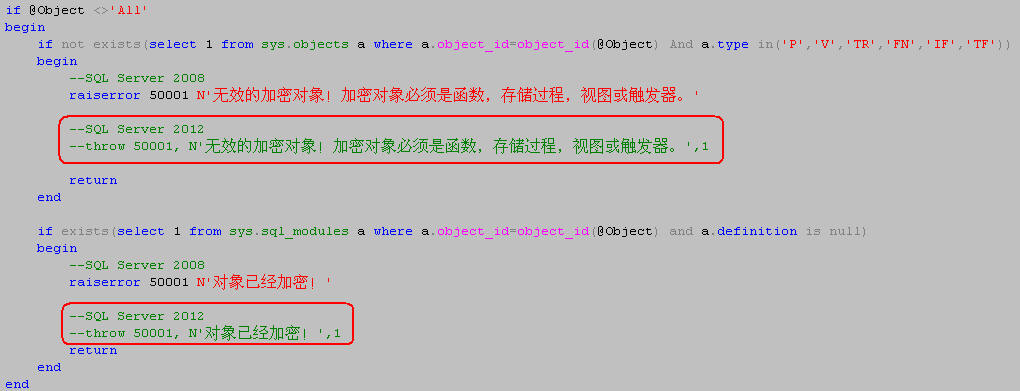
解密方法:
解密过程,最重要采用异或方法:
[字符1]经过函数 fn_x(x)加密变成[加密后字符1],如果我们已知[加密后字符1],反过来查[字符1],可以这样:
[字符1] = [字符2] ^ fn_x([字符2]) ^ [加密后字符1]
这里我列举一个简单的例子:
--创建加密函数(fn_x)
if object_id('fn_x') is not null drop function fn_x
go
create function fn_x
(
@x nchar(1)
)returns nchar(1)
as
begin
return(nchar((65535-unicode(@x))))
end
go
declare @nchar_1_encrypt nchar(1),@nchar_2 nchar(1) --对字符'A'进行加密,存入变量@nchar_1_encrypt
set @nchar_1_encrypt=dbo.fn_x(N'A') --參考的字符@nchar_2
set @nchar_2='x' --算出@nchar_1_encrypt 加密前的字符
select nchar(unicode(@nchar_2)^unicode(dbo.fn_x(@nchar_2))^unicode(@nchar_1_encrypt)) as [@nchar_1] /*
@nchar_1
--------------------
A
*/
[注]: 从SQL Server 2000至 SQL Server 2012 采用异或方法都可以解密
用于解密的存储过程(sp_DecryptObject):
Use master
Go
if object_ID('[sp_DecryptObject]') is not null
Drop Procedure [sp_DecryptObject]
Go
create procedure sp_DecryptObject
(
@Object sysname, --要解密的对象名:函数,存储过程,视图或触发器
@MaxLength int=4000 --评估内容的长度
)
as
set nocount on
/* 1. 解密 */ if not exists(select 1 from sys.objects a where a.object_id=object_id(@Object) And a.type in('P','V','TR','FN','IF','TF'))
begin
--SQL Server 2008
raiserror 50001 N'无效的对象!要解密的对象必须是函数,存储过程,视图或触发器。' --SQL Server 2012
--throw 50001, N'无效的对象!要解密的对象必须是函数,存储过程,视图或触发器。',1
return
end if exists(select 1 from sys.sql_modules a where a.object_id=object_id(@Object) and a.definition is not null)
begin
--SQL Server 2008
raiserror 50001 N'对象没有加密!' --SQL Server 2012
--throw 50001, N'无效的对象!要解密的对象必须是函数,存储过程,视图或触发器。',1
return
end declare @sql nvarchar(max) --解密出来的SQL语句
,@imageval nvarchar(max) --加密字符串
,@tmpStr nvarchar(max) --临时SQL语句
,@tmpStr_imageval nvarchar(max) --临时SQL语句(加密后)
,@type char(2) --对象类型('P','V','TR','FN','IF','TF')
,@objectID int --对象ID
,@i int --While循环使用
,@Oject1 nvarchar(1000) set @objectID=object_id(@Object)
set @type=(select a.type from sys.objects a where a.object_id=@objectID) declare @Space4000 nchar(4000)
set @Space4000=replicate('-',4000) /*
@tmpStr 会构造下面的SQL语句
-------------------------------------------------------------------------------
alter trigger Tr_Name on Table_Name with encryption for update as return /**/
alter proc Proc_Name with encryption as select 1 as col /**/
alter view View_Name with encryption as select 1 as col /**/
alter function Fn_Name() returns int with encryption as begin return(0) end/**/
*/
set @Oject1=quotename(object_schema_name(@objectID))+'.'+quotename(@Object)
set @tmpStr=
case
when @type ='P ' then N'Alter Procedure '+@Oject1+' with encryption as select 1 as column1 '
when @type ='V ' then N'Alter View '+@Oject1+' with encryption as select 1 as column1 '
when @type ='FN' then N'Alter Function '+@Oject1+'() returns int with encryption as begin return(0) end '
when @type ='IF' then N'Alter Function '+@Oject1+'() returns table with encryption as return(Select a.name from sys.types a) '
when @type ='TF' then N'Alter Function '+@Oject1+'() returns @t table(name nvarchar(50)) with encryption as begin return end '
else 'Alter Trigger '+@Oject1+'on '+quotename(object_schema_name(@objectID))+'.'+(select Top(1) quotename(object_name(parent_id)) from sys.triggers a where a.object_id=@objectID)+' with encryption for update as return '
end set @tmpStr=@tmpStr+'/*'+@Space4000
set @i=0
while @i < (ceiling(@MaxLength*1.0/4000)-1)
begin
set @tmpStr=@tmpStr+ @Space4000
Set @i=@i+1
end
set @tmpStr=@tmpStr+'*/' ------------
set @imageval =(select top(1) a.imageval from sys.sysobjvalues a where a.objid=@objectID and a.valclass=1) begin tran
exec(@tmpStr)
set @tmpStr_imageval =(select top(1) a.imageval from sys.sysobjvalues a where a.objid=@objectID and a.valclass=1) rollback tran -------------
set @tmpStr=stuff(@tmpStr,1,5,'create')
set @sql=''
set @i=1
while @i<= (datalength(@imageval)/2)
begin
set @sql=@sql+isnull(nchar(unicode(substring(@tmpStr,@i,1)) ^ unicode(substring(@tmpStr_imageval,@i,1))^unicode(substring(@imageval,@i,1)) ),'')
Set @i+=1
end /* 2. 列印 */ declare @patindex int
while @sql>''
begin set @patindex=patindex('%'+char(13)+char(10)+'%',@sql)
if @patindex >0
begin
print substring(@sql,1,@patindex-1)
set @sql=stuff(@sql,1,@patindex+1,'')
end
else
begin
set @patindex=patindex('%'+char(13)+'%',@sql)
if @patindex >0
begin
print substring(@sql,1,@patindex-1)
set @sql=stuff(@sql,1,@patindex,'')
end
else
begin
set @patindex=patindex('%'+char(10)+'%',@sql)
if @patindex >0
begin
print substring(@sql,1,@patindex-1)
set @sql=stuff(@sql,1,@patindex,'')
end
else
begin
print @sql
set @sql=''
end
end
end end Go
exec sp_ms_marksystemobject 'sp_DecryptObject' --标识为系统对象
go
如果SQL Server 2012,请修改下面两个位置的代码。方法类似于前面的加密过程:
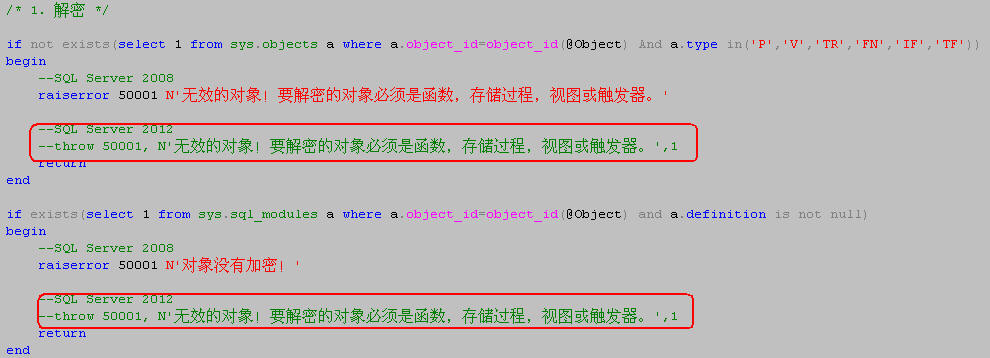
搭建测试环境:
在一个测试环境中(DB: Test),先执行上面的加密存储过程(sp_EncryptObject)和解密存储过程(sp_EncryptObject);再创建两个表:TableA & TableB
use test
go
--创建表: TableA & TableB
if object_id('myTableA') is not null drop table myTableA
if object_id('myTableB') is not null drop table myTableB
go
create table myTableA (ID int identity,data nvarchar(50),constraint PK_myTableA primary key(ID))
create table myTableB (ID int ,data nvarchar(50),constraint PK_myTableB primary key(ID))
go
接下来,我们要创建6个未加密的对象(对象类型包含 'P','V','TR','FN','IF','TF'):
1.视图(myView):
if object_id('myView') is not null drop view myView
go
create view myView
As
select * from TableA;
go
2.触发器(MyTrigger):
if object_id('MyTrigger') is not null drop Trigger MyTrigger
go
create trigger MyTrigger
on TableA
for update
As
insert into TableB(ID,data) select a.ID,a.Data From Inserted a
go
3.存储过程(MyProc):
if object_id('MyProc') is not null drop proc MyProc
go
create proc MyProc
(
@data nvarchar(50)
)
As
insert into TableA(data) values(@data)
go
4.用户定义表值函数(TF)(MyFunction_TF):
if object_id('MyFunction_TF') is not null drop function MyFunction_TF
go
create function MyFunction_TF
(
)
returns @t table
(
id int,
data nvarchar(50)
)
As
begin
insert @t(id,data) select id,data from TableA
return
end
go
5.内联表值函数(IF) (MyFunction_IF):
if object_id('MyFunction_IF') is not null drop function MyFunction_IF
go
create function MyFunction_IF
(
)
returns table
As
return(select top(3) id, data from TableA order by id desc)
go
6.标量函数(FN)(MyFunction_FN):
if object_id('MyFunction_FN') is not null drop function MyFunction_FN
go
create function MyFunction_FN
(
)
returns nvarchar(50)
As
begin
return(select top(1) data from TableA order by id desc)
end
go
当执行完了上面的1-6步骤的脚本,我们通过查询系统视图sys.sql_modules,可以看到未加密前的定义信息:
select b.name as object,b.type,a.definition
from sys.sql_modules a
inner join sys.objects b on b.object_id=a.object_id
where b.create_date>=convert(date,getdate())
order by b.object_id

加密测试:
下面我就通过调用加密存储过程(sp_EncryptObject),一次性对它们进行加密:
use test
go
exec sp_EncryptObject 'all'
go

当我们再查回系统视图sys.sql_modules,会发现definition列返回的是null值,说明定义内容已经给加密:
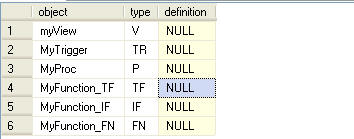
解密测试:
解密过程,必须在DAC连接SQL Server,我们这里例子是从 SSMS(SQL Server Management Studio) 查询编辑器启动 DAC,如图:
解密存储过程(sp_DecryptObject),只能一次对一个存储过程、函数、视图或触发器,进行解密:
use test
go
exec sp_DecryptObject MyTrigger
go

当定义内容长度超过4000,我们可以指定@MaxLength的值,如:
exec sp_DecryptObject fn_My,20000
go
这里(fn_My)是一个函数,定义内容超过了8000:
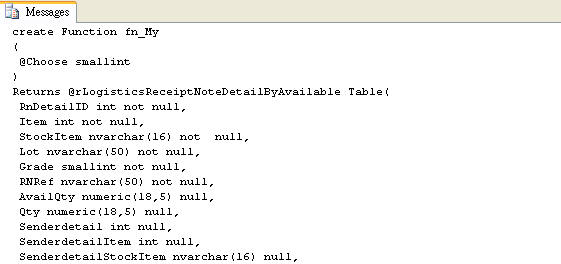
... ...
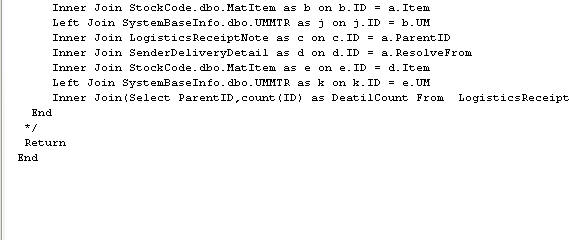
小结:
虽然,上面的脚本,我已经在SQL Server 2008 R2 和SQL Server 2012测试过,但无法避免一些未知错误 。
sql存储过程加密和解密(MSSQL)的更多相关文章
- SqlServer存储过程加密与解密
★ 加密存储过程 ★: IF EXISTS (SELECT name FROM sysobjects WHERE name = 'encrypt_this' AND type = 'P') DRO ...
- (转)对存储过程进行加密和解密(SQL 2008/SQL 2012)
原文地址:http://www.cnblogs.com/wghao/archive/2012/12/30/2837642.html 开始: 在网络上,看到有SQL Server 2000和SQL Se ...
- SQL SERVER 2008破解加密存储过程(修正存储过程过长解密出来是空白的问题)
SQLServer2005里使用with encryption选项创建的存储过程仍然和sqlserver2000里一样,都是使用XOR进行了的加密.和2000不一样的是,在2005的系统表syscom ...
- MS 数据库存储过程加密解密
存储过程加密解密在网上有很多,刚刚好最近需要用到,所以就查询了一下资料.记录一下 加密方法:执行如下存储过程 DECLARE @sp_name nvarchar(400) DECLARE @sp_co ...
- 查看SQL SERVER 加密存储过程,函数,触发器,视图
原文:查看SQL SERVER 加密存储过程,函数,触发器,视图 create PROCEDURE sp_decrypt(@objectname varchar(50))ASbeginset noc ...
- Sql Server数据的加密与解密
Sql Server数据的加密与解密 在sql server中,我们如何为数据进行加密与解密,避免使用者窃取机密数据? 对于一些敏感数据,如密码.卡号,一般不能使用正常数值来存储.否则会有安全隐患.以 ...
- SQL SERVER 2008 使用TDE加密和解密
SQL SERVER 2008 加密和解密,这样的文件在互联网上不胜枚举,本文的寓意还是一样,一为记录,二可以为开发者提供在实现过程中的注意事项. TDE: Transparent data encr ...
- Sql Server简单加密与解密 【转】
前言: 在SQL Server 2005和SQL Server 2008之前.如果希望加密敏感数据,如财务信息.工资或身份证号,必须借助外部应用程序或算法.SQL Server 2005引入内建数据加 ...
- 使用EncryptByPassPhrase和DecryptByPassPhrase对MS SQLServer某一字段时行加密和解密
在数据库实现加密与解密的文章,Insus.NET较早前也有写过,可以在本博客中可以搜索得到. 今天使用EncryptByPassPhrase和DecryptByPassPhrase来简单实现. 在数据 ...
随机推荐
- LPC43xx双核笔记
简介本页提供了一些使用LPC43xx器件双核特性的基本信息.此页面上的信息和专题使用Keil uVision4工具,以双核工程的使用来演示.该工程初始化两个内核以运行FreeRTOS,并采用三色LED ...
- ARM Cortex Design Considerations for Debug
JTAG was the traditional mechanism for debug connections for ARM7/9 parts, but with the Cortex-M fam ...
- Odoo8出现Internal Server Error的解决办法之一
转载地址:http://blog.sina.com.cn/s/blog_7cb52fa80102vaf3.html 问题: 不知怎么回事,我的Odoo8出错了,重装也一样出错信息如下 Inte ...
- WebLogic清理缓存
如果发布到weblogic的工程,登录发现还是原来的代码错误,可尝试清理weblogic缓存: 1.在weblogic控制台中停止应用,删除部署的工程 2.登录weblogic服务器,删除以下目录中的 ...
- Glibc 和 uClibc
转自:https://blog.csdn.net/clirus/article/details/50145959?locationNum=4 最近在搞mips openwrt框架的东西,mipc的GC ...
- 关于websocket集群中不同服务器的用户间通讯问题
最近将应用部署到集群时遇到一个问题,即用户命中不同的服务器导致的用户间无法进行websocket通讯,在网上搜索到类似问题但都没有具体解决方案. 于是用redis的订阅发布功能解决了该问题,具体流程如 ...
- libcurl断点下载遇到的问题
最近游戏把资源(图片.配置.lua)的加载.更新全部改了 ,加载其实还好,就是不走之前的zip解压方式. 以前的大体流程: 下载 –> 启动 –> 解压 –> 更新 –> ...
- byte[],bitmap,drawable之间的相互转换
Byte[]转Bitmap BitmapFactory.decodeByteArray(data, 0, data.length); Bitmap转Byte[] ByteArrayOutputStre ...
- 深入理解多线程(四)—— Moniter的实现原理
在深入理解多线程(一)——Synchronized的实现原理中介绍过关于Synchronize的实现原理,无论是同步方法还是同步代码块,无论是ACC_SYNCHRONIZED还是monitorente ...
- [转]memcached+magent实现memcached集群
From : http://www.cnblogs.com/happyday56/p/3461113.html 首先说明下memcached存在如下问题 本身没有内置分布式功能,无法实现使用多台Mem ...
